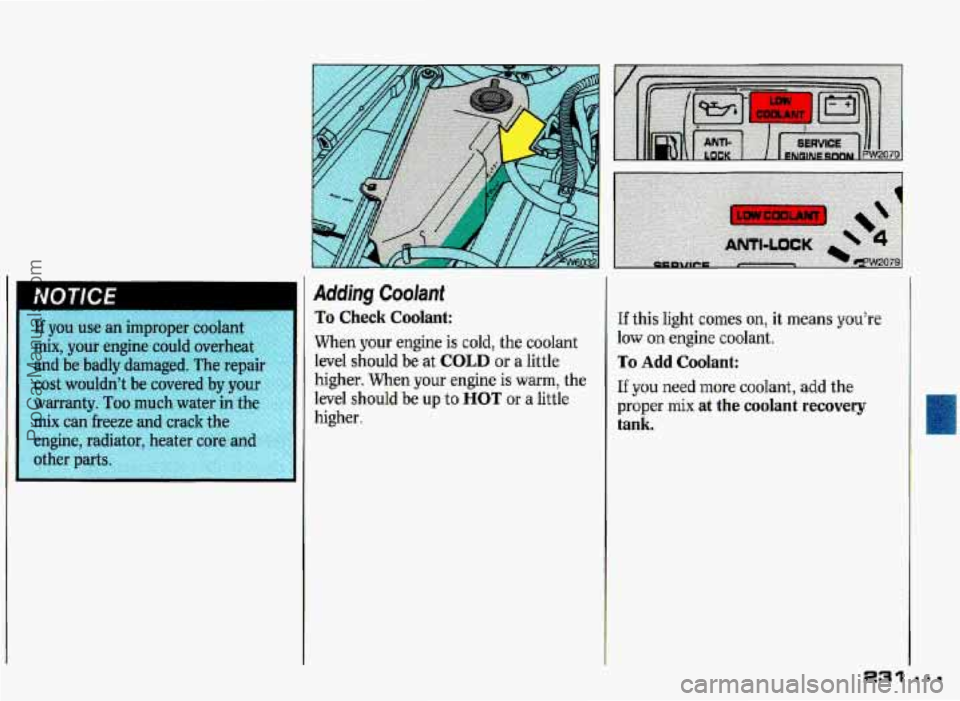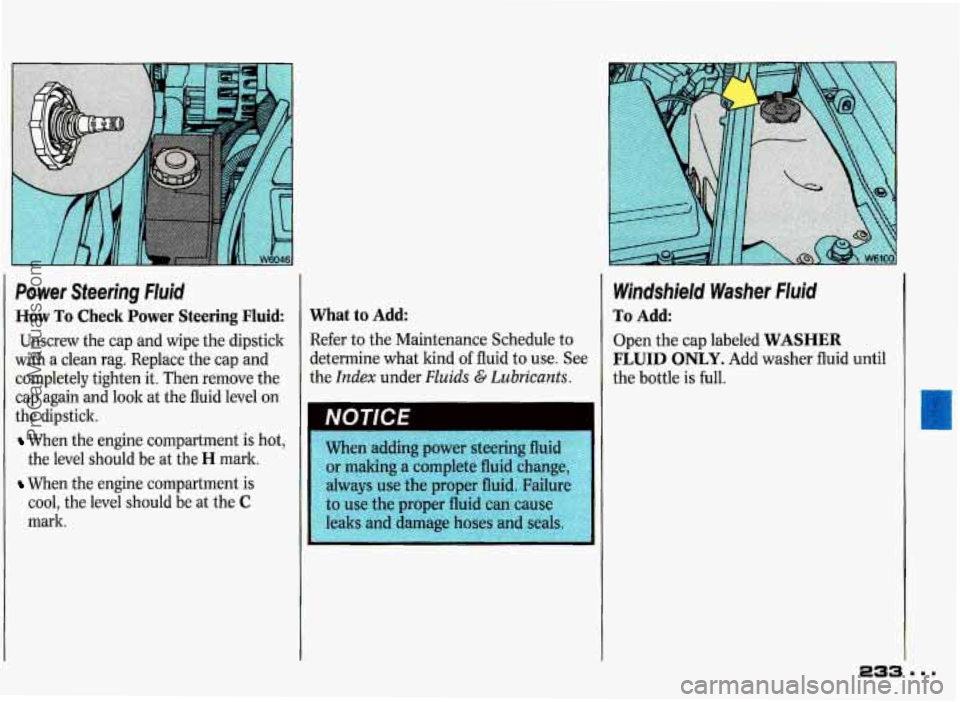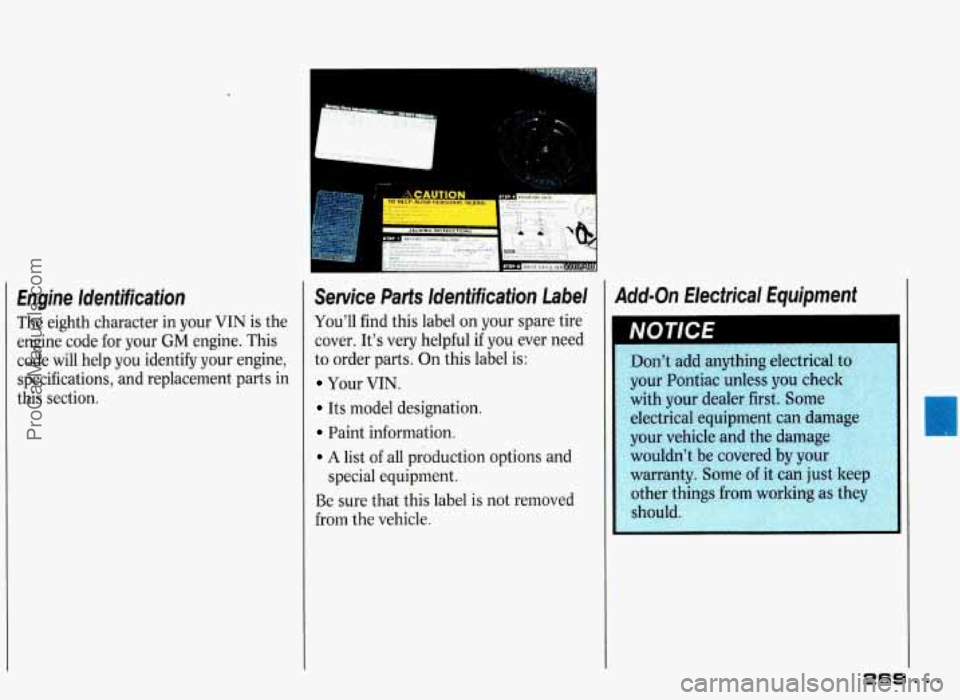1993 PONTIAC GRAND-PRIX check engine
[x] Cancel search: check enginePage 232 of 338

I
NOTICE
If you use an improper coolant
mix, your engine could overheat
and be badly damaged. The repair
cost wouldn’t be covered by your
warranty. Too much water in the
mix can freeze and crack the
engine, radiator, heater core and
other parts.
i,,~~~,~,,”;l,,I;i,.,t”. ~~,,,~,~,~~~~,~,~~.~~~,~
Adding Coolant
To Check Coolant:
When your engine is cold, the coolant
level should be at
COLD or a little
higher. When your engine is warm, the
level should be up to
HOT or a little
higher.
If this light comes on, it means you’re
low on engine coolant.
To Add Coolant:
I€ you need more coolant, add the
proper mix at the coolant recovery
tank. n
ProCarManuals.com
Page 234 of 338

Power Steering Fluid
How To Check Power Steering Fluid:
Unscrew the cap and wipe the dipstick
with a clean rag. Replace the cap and
completely tighten it. Then remove the
cap again and look at the fluid level on
the dipstick.
When the engine compartment is hot,
the level should be at the
H mark.
When the engine compartment is
cool, the level should be at the
C
mark.
What to Add:
Refer to the Maintenance Schedule to
determine what kind of fluid to use. See
the
Index under Fluids G Lubricants.
When adding power steering fluid
or making a complete fluid change,
always use the proper fluid. Failure
to use the proper fluid can cause
leaks and damage hoses and seals.
Windshield Washer Fluid
To Add:
Open the cap labeled WASHER
FLUID ONLY. Add washer fluid until
the bottle is full.
ProCarManuals.com
Page 270 of 338

Engine Identification
The eighth character in your VIN is the
engine code for your
GM engine. This
code will help you identify your engine, specifications, and replacement parts in
this section.
Service Pads Identification Label I Add-on EIecfrical Equipment
You'll find this label on your spare tire
cover. It's very helpful if you ever need
to order parts. On this label is:
Your VIN.
Its model designation.
Paint information.
A list of all production options and
special equipment.
Be sure that this label is not removed
from the vehicle.
- I
Don't add anything electrical to
your Pontiac unless
you check
with your dealer first. Some
electrical equipment can damage
your vehicle and the damage
wouldn't be covered by your
ProCarManuals.com
Page 271 of 338

Service & Appearance Care
nnm i
Fuses & Circuit Breakers
The wiring circuits in your vehicle are
protected
from short circuits by a
combination of fuses, circuit breakers,
and fusible thermal links in the wiring
itself. This greatly reduces the chance
of
fires caused by electrical problems.
Some fuses are located in a fuse block
in the glove box as shown above.
To
locate the fuse block, pull down the
cover. See the diagram later in this
section.
Another set
of fuses is located in the
component center, under the
instrument panel.
Additional fuses are located in the
underhood electrical centers on the
right and left sides of the engine
compartment.
270
Spare fuses and a fuse puller are located
in the glove box fuse block cover.
Place the wide end of the fuse puller
over the plastic end of the fuse. Squeeze
the ends over the fuse and pull it out.
To identify and check fuses, refer to the
charts on the following pages. Look at the silver-colored band inside
the fuse.
If the band is broken or
melted, replace the fuse. Be sure you
replace a bad fuse with a new one of the
identical size and rating.
ProCarManuals.com
Page 288 of 338

IMPORTANT
KEEP ENGINE OIL
AT THE PROPER
LEVEL AND CHANGE
AS
RECOMMENDED
This part covers the maintenance
required for your Pontiac. Your
vehicle needs these services to retain its safety, dependability and emission
control performance.
Have you purchased the GM
Protection Plan?
The Plan supplements your new
vehicle warranties. See your Pontiac dealer for details.
Part 7 '.
Maintenance Schedule
Section
Introduction
A Word About Maintenance .......................................................... 288
Your Vehicle and the Environment
................................................ 288
How This Part is Organized
........................................................... 289
A. Scheduled Maintenance Services
Using Your Maintenance Schedules .............................................. 290
Selecting the Right Schedule
.......................................................... 290
Schedule
I ........................................................................\
............... 292
Schedule
I1 ....... .............................................................. .. ........... .... 294
Explanation
of Scheduled Maintenance Services ... ... . . . . . . . . . . . . . . . . . . . 296
B. Owner Checks & Services
At Each Fuel Fill ........................................................................\
..... 299
At Least Once a Month
.................................................................. 299
At Least Twice a Year
..................................................................... 299
At Least Once a Year
...................................................................... 300
C. Periodic Maintenance Inspections ....................................................... 302
D. Recommended Fluids & Lubricants .................................................... 303
E. Maintenance Record ........................................................................\
...... 306
ProCarManuals.com
Page 297 of 338

Maintenance Schedule
Section A: Scheduled Maintenance Services t~ont.3
Explanation of Scheduled Maintenance Services
Below are explanations of the services listed in Schedule I
and Schedule 11.
ITEM
NO. SERVICE
1 Engine Oil and Filter Change’:-Always use SG
Energy Conserving I1 oils for proper viscosity. The
“SG” designation may be shown alone or in
combination with others, such as “SG/CC,”
“SG/CD” or
“SF, SG, CC,” etc. To determine the
preferred viscosity for your vehicle’s engine (e.g.,
SAE
5W-30 or SAE 1OW-30) see the Index under
Engine OiZ. If your vehicle is equipped with an
Engine Oil-Change Indicator (EOCI)
, the
indicator will show you when to change oil. See
the
Index under Driver Information Center.
2 Chassis Lubrication-Lubricate the transaxle shift
linkage, parking brake cable guides, underbody
contact points and linkage. Lubricate the front and
rear suspension and steering linkage. The
proper fluids and lubricants to use are listed in Section
D. Make sure whoever services your vehicle uses these. All
parts should be replaced and all necessary repairs done
before you or anyone else drives the vehicle.
ITEM
NO. SERVICE
3 Throttle Body Mounting Bolt Torque (3.1L
Code T engine only)‘x- Check the torque of the
mounting bolts and/or nuts.
Tire and Wheel Rotation and Inspection -For
long wear and maximum tire life, rotate your tires
following the instructions in this manual. See the
Index under Tires, Inspection G. Rotation. Check
the tires for uneven wear or damage.
If you see
irregular or premature wear, check the wheel alignment. Check for damaged wheels also.
4
a The U.S. Environmental Protection Agency has determined that the failure to perform this maintenance item will not nullify the emission warranty or
limit recall liability prior to the completion of vehicle useful life. General Motors, however, urges that all recommended maintenance services be
performed at the indicated intervals and the maintenance be recorded
in Section E: Maintenance Record.
296
ProCarManuals.com
Page 298 of 338

ITEM
NO. SERVICE
ITEM NO. SERVICE
5
6
Engine
Accessory Drive Belt Inspection
(California
3.1L Code T, engine*)-Inspect the
belt for cracks, fraying, wear and proper tension.
Replace as needed,
Camshaft Timing Belt Inspection
(3.4L Code X
engine only)*-Inspect for cracks, wear or oiliness.
Check tensioner for proper operation. See the
service manual. (To purchase a service manual,
see the
Index under Publications.) Replace parts
as needed.
7 Cooling System Service*-Drain, flush and refill
the system with new or approved recycled coolant
conforming to
GM Specification 1825111. Keep
coolant at the proper mixture as specified. See the
Index under Coolant. This provides proper freeze
protection, corrosion inhibitor level, and engine
operating temperature.
Inspect hoses and replace if they are cracked,
swollen or deteriorated. Tighten screw-type hose
. clamps. Clean the outside of the radiator and air
conditioning condenser. Wash the pressure cap
and neck.
To help ensure proper operation, we recommend a
pressure test of both the cooling system and the
pressure cap.
8 Transaxle Service-For manual transaxles, fluid
doesn’t require changing.
For automatic transaxles, change both the fluid
and filter every
15,000 miles (25 000 lun) if the
vehicle is mainly driven under one or more of
these conditions:
In heavy city traffic where the outside
temperature regularly reaches
90°F (32°C) or
higher.
In hilly or mountainous terrain.
9
10
When doing frequent trailer towing. (With some
models,
you shouldn’t ever tow a trailer. See the
Index under Towing a Trailer.)
Uses such as found in taxi, police car or delivery
service.
If you do not use your vehicle under any
of these
conditions, change both the fluid and filter every
100,000 miles (160 000 km).
Spark Plug Replacement *-Replace spark plugs
with the proper type. See the
Index under
Replacement Parts.
Spark Plug Wire Inspection*+Inspect for
burns, cracks
or other damage. Check the boot fit
at the coils and at the spark plugs. Replace wires
as needed.
ProCarManuals.com
Page 300 of 338

Section B: Owner Checks & Services
Listed below are owner checks and services which should be
performed at the intervals specified to help ensure the
safety, dependability and emission control performance of
your vehicle. Be
sure any necessary repairs are completed at once.
Whenever any fluids or lubricants are added
to your vehicle,
make sure they are the proper ones, as
shown in Section D.
At Each Fuel Fill (It is important for you or a sewice station attendant to perform these underhood checks at each fue\
l fill..)
CHECK
OR SERVICE WHAT TO DO
i
I Engine Oil Level
Check the engine oil level and add
the proper oil if necessary. See the Index under Engine Oil for
further details.
I
Engine Coolant Level Check the engine coolant level in the coolant recovery tank and add the proper coolant mix if
I necessary. See the Index under Coolant for further details.
Windshield Washer See the
Index under Windshield Washer Fluid for further details.
Fluid Level Check the windshield washer fluid level in
the windshield washer tank and add fluid
if necessary.
At Least Once a Month h
CHECK
OR SERVICE WHAT TO DO
Tire Inflation
Check tire inflation. Make
sure they are inflated to the pressures specified on the Tire-Loading
Information label located on the rear edge of the driver’s door or inside the trunk lid. See the
Index under Tires for further details.
At Least Twice a Year h I CHECK
OR SERVICE WHAT TO DO
Hydraulic Clutch
in this system could indicate a problem. Have the system inspected and repaired at once.
System Inspection Check the fluid level in
the clutch reservoir. See the Index under Hydraulic Clutch. A fluid loss
ProCarManuals.com